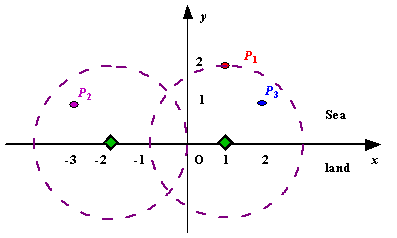Radar Installation
| Time Limit: 1000MS | Memory Limit: 10000K | |
| Total Submissions: 30071 | Accepted: 6607 |
Description
Assume the coasting is an infinite straight line. Land is in one side of coasting, sea in the other. Each small island is a point locating in the sea side. And any radar installation, locating on the coasting, can only cover d distance, so an island in the sea can be covered by a radius installation, if the distance between them is at most d.
We use Cartesian coordinate system, defining the coasting is the x-axis. The sea side is above x-axis, and the land side below. Given the position of each island in the sea, and given the distance of the coverage of the radar installation, your task is to write a program to find the minimal number of radar installations to cover all the islands. Note that the position of an island is represented by its x-y coordinates.

Figure A Sample Input of Radar Installations
We use Cartesian coordinate system, defining the coasting is the x-axis. The sea side is above x-axis, and the land side below. Given the position of each island in the sea, and given the distance of the coverage of the radar installation, your task is to write a program to find the minimal number of radar installations to cover all the islands. Note that the position of an island is represented by its x-y coordinates.

Figure A Sample Input of Radar Installations
Input
The input consists of several test cases. The first line of each case contains two integers n (1<=n<=1000) and d, where n is the number of islands in the sea and d is the distance of coverage of the radar installation. This is followed by n lines each containing two integers representing the coordinate of the position of each island. Then a blank line follows to separate the cases.
The input is terminated by a line containing pair of zeros
The input is terminated by a line containing pair of zeros
Output
For each test case output one line consisting of the test case number followed by the minimal number of radar installations needed. "-1" installation means no solution for that case.
Sample Input
3 2 1 2 -3 1 2 1 1 2 0 2 0 0
Sample Output
Case 1: 2 Case 2: 1
Source
解题报告:求出每个点的雷达所能安放的范围,再利用经典的活动安排的贪心算法即可
代码如下:
#include <iostream>
#include <cstring>
#include <cstdio>
#include <cstdlib>
#include <cmath>
using namespace std;
const int N = 1010;
struct point
{
double x;
double y;
}p[N]; //点的信息
struct node
{
double begin;
double end;
}a[N]; //雷达所能安放的位置范围
int visit[N];
int cmp(const void *a, const void *b)//排序函数
{
return (*(struct node *)a).end > (*(struct node *)b).end ? 1 : -1;
}
double Max(double x, double y)
{
return x > y ? x : y;
}
int main()
{
int n, d, i, j, ans, count = 0;
double max, len;
while (scanf("%d%d", &n, &d) != EOF && n && d)
{
max = 0;
memset(p, 0, sizeof(p));
for (i = 0; i < n; ++i)
{
scanf("%lf%lf", &p[i].x, &p[i].y);
max = Max(max, p[i].y);//找出纵坐标的最大,以便比较和雷达扫描半径的大小
}
getchar();
getchar();
count ++;
if (max > d || d < 0)
{
printf("Case %d: -1\n", count);
}
else
{
memset(a, 0, sizeof(a));
memset(visit, 0, sizeof(visit));
for (i = 0; i < n; ++i)
{
len = sqrt(1.0 * d * d - 1.0 * p[i].y * p[i].y);
a[i].begin = p[i].x - len;
a[i].end = p[i].x + len;
}
qsort(a, n, sizeof(a[0]), cmp);
ans = 0;
for (i = 0; i < n; ++i)
{
if (!visit[i])
{
visit[i] = 1;
for (j = 0; j < n; ++j)//使用的是经典的活动安排的贪心算法
{
if (!visit[j] && a[j].begin <= a[i].end)
{
visit[j] = 1;
}
}
ans ++;
}
}
printf("Case %d: %d\n", count, ans);
}
}
return 0;
}



